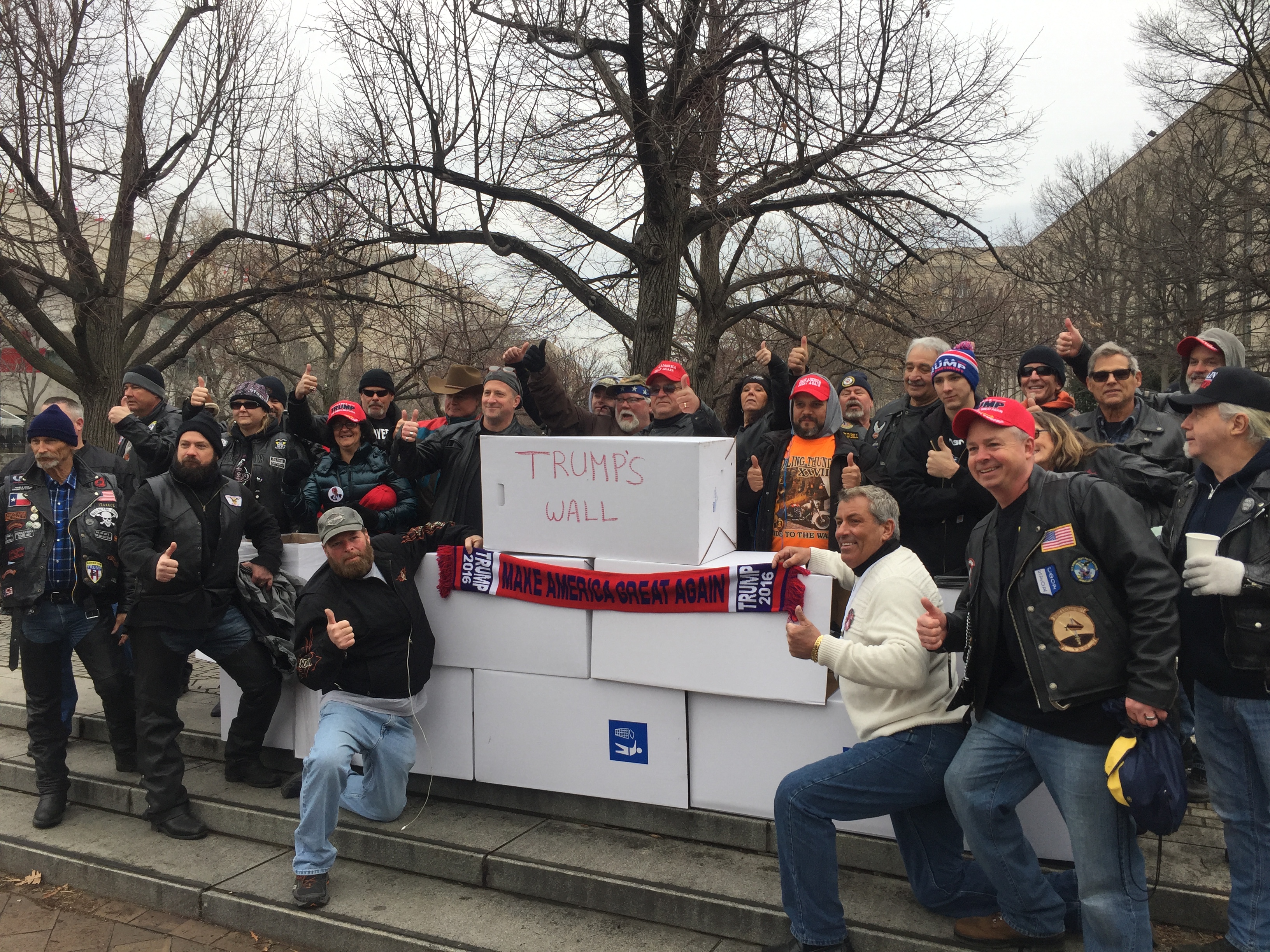The neighborhood of Shaw, a half-hour’s walk north of the National Mall and a stone’s throw from Howard University, was once a center of black cultural life in Washington, D.C. It was devastated in the 1968 riots over the assassination of Martin Luther King and the flight to the suburbs that followed, and spent several decades as a hollowed-out slum. Now, like so many black urban neighborhoods in America, it is gentrifying. Shaw has a Warby Parker store and high-rise luxury apartment buildings with swimming pools on their roofs. In 2015, the New York Times published a story about the influx of white millennials to the area. All inaugural weekend, the lines at the local coffee shop were filled with anxious people, most of them white. There was hardly a red baseball cap to be found in the neighborhood.
On the day before Donald Trump was sworn in as president of the United States of America, I was working from one of Shaw’s luxury apartments–rented on Airbnb–when I received a phone call from Rick Loom, the CEO of a company called Demand Protest. “I think it’s about time that somebody released the 1947 Roswell documents,” he said, his voice beamed to my iPhone speaker via satellite from San Francisco or New York. “We don’t have all of our operatives at the inauguration, but this is going to be our singular focus going forward.”
Demand Protest had just been at the center of a right-wing media firestorm, after placing ads on the website Backpage that offered $50 per hour plus a $2500 monthly retainer to anyone who was willing to demonstrate against Trump’s inauguration. The appearance of the ads confirmed a long-standing suspicion of the fringe right that leftist protest movements like Black Lives Matter and the opposition to Trump are secretly controlled and paid for by the global philanthropist George Soros and other wealthy liberals. “With absolute discretion a top priority, our operatives create convincing scenes that become the building blocks of massive movements. When you need the appearance of outrage, we are able to deliver it,” Demand Protest’s slick website reads.
“The leftist mob is NEVER grassroots,” responded the Gateway Pundit blog, one of several conservative internet mainstays to pick up the Demand Protest story last week. “It always includes paid activists.”
Demand Protest, of course, was an elaborate hoax, designed to undermine the credibility of legitimate protesters, or the right-wing media, or the media in general, or everyone–a hoax so obvious that even a hack like Tucker Carlson was able to call it out as such. The company claims to have worked on 48 campaigns, but its website only appeared in December, one month before the anti-Trump ads went up last week; Demand Protest is not registered as a taxable entity in California, where it supposedly operates; the company representative who appeared on Carlson’s show used a fake name. And why would a company that prioritizes “absolute discretion” post public advertisements and send its employees to appear on national television? Despite all the evidence, Rick Loom–also a fake name, naturally–was playing it pretty straight on the phone, aside from the winking reference to Roswell.
If Loom’s mission with the Demand Protest was to expose a credulous, fact-averse media, I wondered if he had any qualms over spreading disinformation about protesters himself.
“I take issue with the very question, because we are legitimate protesters,” he replied when I asked. “We are 100 percent legitimate, and I actually don’t even understand the question.”
Company policy aside, then, what did he personally think about the phenomenon of “fake news” discussed in the wake of Trump’s election?
“I think it’s clickbait taken to its logical conclusion,” he said. “If the entire internet is based on advertising revenue, and the only way to make money is to get the most clicks and views, you’re going to optimize for what gets clicks and views, not necessarily what’s good reporting. That’s my personal opinion on fake news. My professional opinion, with Demand Protest, is that it’s an excellent way for us to manipulate the media and get our message out for our clients, like the unnamed client who is hiring us to do the inauguration.”
In this instance, Rick Loom is correct. The only difference between Demand Protest and the scores of ridiculously popular false stories that followed Donald Trump on his way to presidential victory is intent. Many of these stories, with headlines like “BREAKING: Hillary Clinton Indicted, Your Prayers Have Been Answered” (shared 140,000 times on Facebook), originated from teenagers working from the same tiny town in Macedonia, exploiting the same unregulated, click- and share-driven news market that brought us Demand Protest. These teens are not politically motivated propagandists, or anarchic pranksters like Loom. They were simply participating in the great American tradition of making a quick buck. “I started the site for a easy way to make money,” the 17-year-old operator of one Macedonian fake news site told Buzzfeed in November. “People in America prefer to read news about Trump,” added another, 16 years old.
Meanwhile, at rallies, Trump himself worked hard to discredit nearly every outlet in the mainstream media, many of which had been critical of his demagogic campaign. The result of these factors, and of other, longer-brewing ones–like the decay of the newspaper, and the rise of the 24-hour cable news cycle, the internet, and extreme partisan figures like Matt Drudge, Alex Jones, and Andrew Breitbart–was a significant erosion of America’s trust in the old institutions of the press. Today in America, plenty of people believe that there is an occult child sex-ring operated by elite Democratic Party allies in the basement of an unassuming pizza joint in Northwest Washington. One of these believers was convinced enough to strap on his assault rifle and investigate for himself.
The end of consensus over what is true and what is false is among the most obvious indicators of the new American era that Trump rang in, but it is not the only one. We’ve also seemed to reach the end of consensus over the American project in general, the end of our faith in the idea that the two political parties are engaged in a slow compromise, working out their differences over generations in hopes of finding some sensible middle ground that all Americans can live happily with. After experiencing the economic effects of deregulation and cutbacks carried out by both parties, Americans no longer believe in the political establishment or the political center, or what they are meant to represent. The Republicans realized this a long time ago, stoking the poverty their own policies helped create into racial hatred and fear, then satisfying that fear with calls for law and order and increasingly open xenophobia. The Democrats are still playing catch-up. The immediate result of this fissure is a terrifying one: We’ve elected a man as our leader who seems to hate women and Muslims and Latin Americans, who has no governing experience, who will separate immigrant mothers from their children and strip wage workers who believed in his populism of their access to healthcare, who rose to national fame by firing people on prime-time television.
“Don’t you feel like the government is bamboozling us?”
Those of us who oppose Trump’s presidency and agenda will spend the next four or eight years clinging to tiny victories. The first came early: On the National Mall on Friday morning, it began to rain at almost the exact moment the new president began his first inaugural address. Aerial photography later made it clear that the crowds were much smaller than at either of Barack Obama’s inaugurations. Among the Trump administration’s first public statements were bizarre lies about these two seemingly indisputable facts. “I looked at the rain, which just never came…it’s like God was looking down on us,” Trump said at the Liberty Ball that evening. White House Press Secretary Sean Spicer used a press briefing on Saturday to condemn journalists for reporting “inaccurate numbers involving crowd size.” Immediately after assuming the presidency, in a brazen betrayal of his populist campaign, Trump signed an executive order that will result in higher mortgage payments for millions of American homeowners.
Wandering among the inauguration crowd on Friday, I met Senen Pitaluga, a second-generation Cuban-American immigrant and Trump supporter who’d ridden his motorcycle to D.C. from his home in New Jersey. “The main thing that got my attention was that every single politician and news outlet was against him,” he said, holding a stubby cigar between his fingers. “Don’t you feel like the government is bamboozling us? Everybody feels that way but no one wants to come out and say it.” I asked Pitaluga whether Trump’s open hostility to immigrants made him uncomfortable, given his family’s history. “They came here legally. They got jobs. We have an epidemic of people flowing over the border, and soon there’s going to be more terrorists here than anywhere else. They can come here, but vet them,” he answered.
Another biker, who’d come from South Dakota and referred to himself only as “Fat Bob”–the name of the Harley-Davidson model he’s been riding since the ‘70s–was less conciliatory about immigration. The back patches on his motorcycle vest read “Helmet laws suck,” “Speak English or get the fuck out,” and “Injection is nice but I’d rather be blown.” He liked Trump because “He wants to build the wall and keep illegal immigrants out–key word illegal, as always,” he said. I asked him what he thought about anti-Trump protesters and he made a farting noise with his mouth. “That’s my description of them.”

In the middle of our conversation, a genteel-looking man in a sweater bummed a cigarette from Fat Bob. “What, did you guys have trouble getting through security? I thought there was supposed to be 5,000 Bikers for Trump here,” he said. There were maybe three dozen bikers gathered there, near the intersection of Pennsylvania and Constitution Avenues. Behind us, they’d stacked ten cardboard trash cans and written “Trump’s Wall” on the side. Trump supporters passing by continually stopped to take pictures with the bikers, the mythical gritty workingmen in a sea of well-heeled women with purses and baby-faced boys in blue suits. “U-S-A!” and “Lock her up!” chants periodically broke out among the crowd, each in the same staccato rhythm, three beats and a rest on the four.
Security was heavy, with snipers standing sentinel on rooftops and Secret Service checkpoints with metal detectors and agents that rifled through attendees’ bags. On D Street at around 10:30, a crowd of supporters, protesters, and journalists walked back and forth, searching for a checkpoint that would offer access to non-ticketed areas of the mall. Inside one such entry that had since been closed off, an attendee in a leather jacket and Cowboy hat spread his arms like Moses and shouted “Let my people in!” Nearby, an evangelist with a megaphone urged the crowd to “put on the armor of light,” and others held stark black-and-white sings with eschatological slogans: “Life is a vapor. Repent or perish,” “The spirit of whoredom is in your midst,” “The pope is an Antichrist.” A blown-up image showed the tiny, bloody hand of a fetus against George Washington’s face on the quarter. For a moment, with the swirling dread in the air, the police helicopters hovering above, and the prospect of a Trump presidency looming ahead, it felt like the apocalypse preachers were onto something.
“Police want us quiet. We’ve hardly spoken.”
At 12th and K Streets on Friday afternoon after the inauguration, I spoke with Angel Marlin, a young black woman with purple hair and a hearing aid. We were standing in front of a line of riot police multiple rows deep, with an array of different colored helmets and shields in various shapes. Small pockets of protests led by militant anti-fascists and anarchists were erupting in the area. A few minutes earlier, the police had deployed tear gas against demonstrators who, according to Marlin, had been peacefully marching. “Trump, he has disrespected most of society, most of America,” she said, her speech slow and measured. “Why would we want him in office, when we can’t have the same rights we’ve fought for for decades? A police officer hit one of my people. So many things were getting thrown. We were running away, we kept screaming, ’stop.’ We did nothing wrong.”
The gassing had mostly cleared the intersection out of people, bringing an eerie stillness—only a few dozen protesters remained, with at least as many police officers and members of the media, too late for the action. Vermin Supreme, an absurdist performance artist who wears a rubber boot on his head and frequently runs stunt presidential campaigns, ranted into a megaphone about rifts in the space-time continuum and sang a song about hot dogs and applesauce. Down the line, a protester attempted to impart the officers in front of him with a new class consciousness. “You think you’re protecting us, preserving our freedoms?” he shouted. “You’re here because you’re in debt. You’re here because you need to pay rent, because of the shackles that have been placed on us that we can’t even see.” A correspondent for a foreign television network shoved a microphone into his face, and everyone else stared at their smartphone screens.
Marlin first approached me because of something she’d read over my shoulder in my notebook, a transcription of a conversation between two college-aged guys who were standing behind me. One of them had snapped a photo of the ominous police line, and asked his partner, “What’s a good caption for this picture?” After I jotted this snippet down, Marlin tapped my shoulder, took my pen and notebook, and wrote out an answer to his question. “Police want us quiet,” it read. “We’ve hardly spoken.”
About an hour later and a block away, a limousine went up in flames. Two teenagers began by kicking and performing WWF-style elbow drops on an adjacent official-looking black SUV on the northeast corner of Franklin Square Park, to mixed cheers and reprimands from the surrounding throngs. “Give it the people’s elbow!” one man yelled. “This is going to be all over Fox News tomorrow!” another answered. “We are giving into Trump. This is what they want. We are so much better than this.”
And then the fire came, engulfing the entire limo almost immediately. Hundreds of people started fleeing across the park, fearing it might explode. A line of cops with shields materialized from the north on K street, rotating towards us in a rigid line, like the minute hand of a giant clock. They threw flash bangs into the crowd, setting off miniature but terrifying explosions of noise and white light. At first, I thought they were shooting, and my boots slipped across the muddy hillside as I backed away. Vermin Supreme was back with his megaphone: “A safety tip! Walk, but do not run, away from the fire and the police.”

For the next hour or so, the rioters and police engaged in a lurching, violent dance. The cops threw a flash bang, or used pepper spray or tear gas, and the crowd retreated. The crowd paused for recovery, with an impromptu medic team offering blankets and milk to wash the eyes and bodies of those who’d been hit hardest by the spray. The crowd advanced slowly back toward the police line, and inevitably a few people began lobbing rocks and bricks toward the cops. The cops deflected the rocks with their shields, took out their flashbangs and gas cans, and the cycle began again. All the while, a corps of bucket drummers pounded out martial rhythms, and as the fracas wound down, a P.A. system on the opposite side of the park began blasting “War Pigs” by Black Sabbath.
It was easy to fret over the fighting, its optics and its effects, whether the sucker punch given to the openly white supremacist leader and Trump supporter Richard Spencer was an appropriate expression of disapproval for his promotion of racism. But politicians and pundits have been saying for the last year that a Trump presidency was an existential threat to American democracy; on the day the man was sworn in as leader of the free world, the anarchists and antifascists were the only ones acting like they believed it. Two hundred and thirty protesters were arrested, the majority of them on “felony rioting” charges that carry a sentence of up to 10 years in prison.
After a campaign fueled in part by hatred of the media and politics as usual, the setting for the violence was oddly appropriate, outside the home of a press institution that has spent the last century and a half soberly reporting on our nation’s leaders, the default house organ of the political center. The smoke wasn’t brushing the sides of the White House, or the Trump International Hotel, a 15 minute walk to the southeast, but the headquarters of the Washington Post.
“Everything is under assault”
Deborah Wagner, a compact middle-aged attorney and mother from Cincinnati, stood near the corner of the National Gallery of Art on Saturday afternoon, wearing a sage green fleece pullover and glasses. Her smile was polite, and the sign she held was decidedly not–the words ”NAZI PUNKS FUCK OFF” were written on the posterboard in her hand. “It’s actually my son’s sign,” she said with a laugh, nodding up at a sullen-looking teenager sitting cross-legged on the stone wall behind her. “I taught him to listen to old-school punk.”
We were at the Women’s March, a gathering of hundreds of thousands of people in downtown D.C., peacefully protesting Trump’s plans to gut healthcare, defund Planned Parenthood, ban Muslims, conduct mass deportations and build a wall on the Mexican border. Across the country, hundreds of thousands more were similarly demonstrating in their own urban centers. High above the seas of pink “pussyhats,” a light fog briefly obscured the tip of the phallic Washington Monument.
Wagner, whose work includes advocacy for affordable housing the First Amendment rights of protesters, is one of the hundreds of thousands concerned about the precedent Trump’s administration would set. “He needs to understand that we are the majority, that we are the people of this country, and our voices will be heard,” she said when asked about what would need to happen to stop Trump’s agenda. “We have to stand up and show him that we won’t stand for this.”
“I feel like everything is under assault,” she continued. “I feel like we need to protect everything.”

The old model of politics also has its grave faults: it brought us Jim Crow, Guantanamo Bay, the incarceration of hundreds of thousands of black men and the killing by police of dozens of others each year. It handed the reins of our elections to a small circle of impossibly rich donors, struck down regulations that might have prevented the housing crisis, allowed Republicans to strip away the safety net of the welfare state, left millions of formerly working people in poverty with no meaningful way out.
Donald Trump’s answers to America’s problems are all of the wrong ones. Many of the problems he identifies aren’t problems at all–his plans for a Muslim ban and border wall, and his figurative and literal assaults on women, should have been immediately disqualifying. But our new president won in part because he was canny enough to point out that the American system is breaking down. He won because at some point along the way in our history, something in America went horribly wrong.
The Women’s March in D.C. saw no arrests, a noticeable contrast to the violence from the day before. A diversity of factions put aside its differences to demonstrate against Trump: Bernie supporters and Hillary loyalists, socialists and moderate liberals, hammer-and-sickle signs deployed sincerely to signal support for communism and ironically to express worry over Trump’s relationship with Russia. One man held an “Unpaid Protester” sign, a cheeky rebuke to the paranoid right-wing media coverage of the previous week.
Making it through the Trump administration and beyond will require the unity found at demonstrations like the Women’s March, more direct advocacy of the kind that Wagner carries out in Cincinnati, a free and adversarial press that does not crumble under the White House’s attempts to undermine it. The Democratic Party must pick itself up and devise a plan to meaningfully connect with and better the lives of working people of all races, religions, sexual orientations, and gender identities, one that does not succumb to Trump’s vile appeals to hatred.
On Saturday, Brianna Lloyd, a sixth-grade math teacher in the hardscrabble Boston neighborhood of Roxbury, marched west in a column on Constitution Avenue, a block away from Friday’s inaugural parade route. When she told her students she’d be out of school to protest the inauguration on Friday, they provided her with their concerns for the president, scrawled on multicolored post-it notes. Lloyd collected them on a piece of poster board under the heading “Mr. President, my students have questions,” and carried it over her head as she walked: “Will America be better?” “Will you help people that are sick?” “Will you give money to schools?” “Please be nice,” “Why do you hate women?” “Why do you hate black people?” “Are you OK?” Multiple notes simply asked “Why?”





